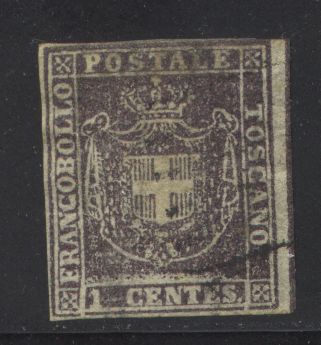
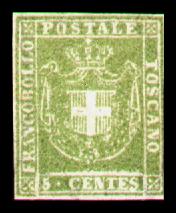
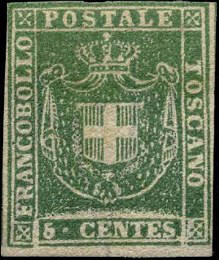
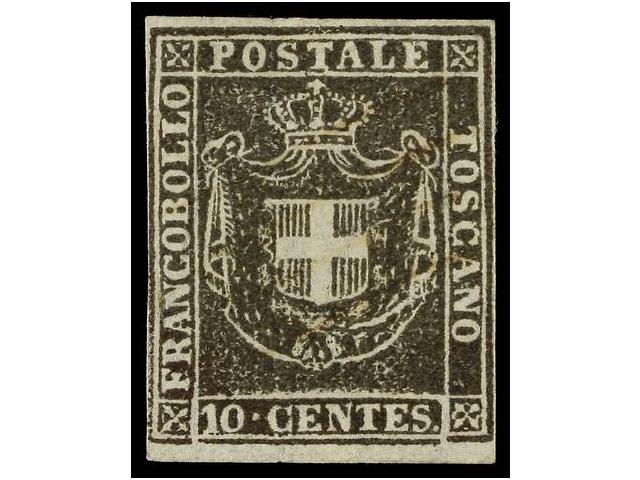
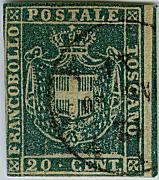
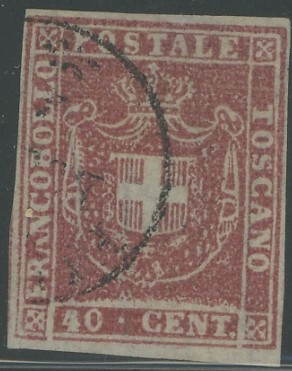
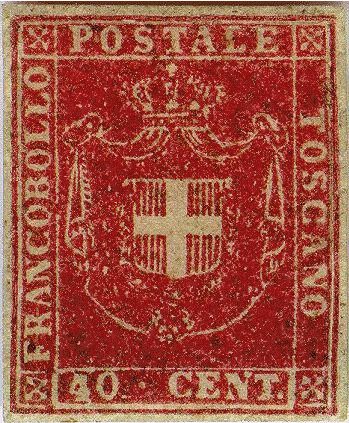
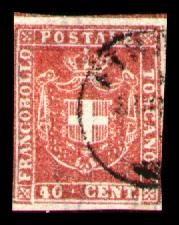
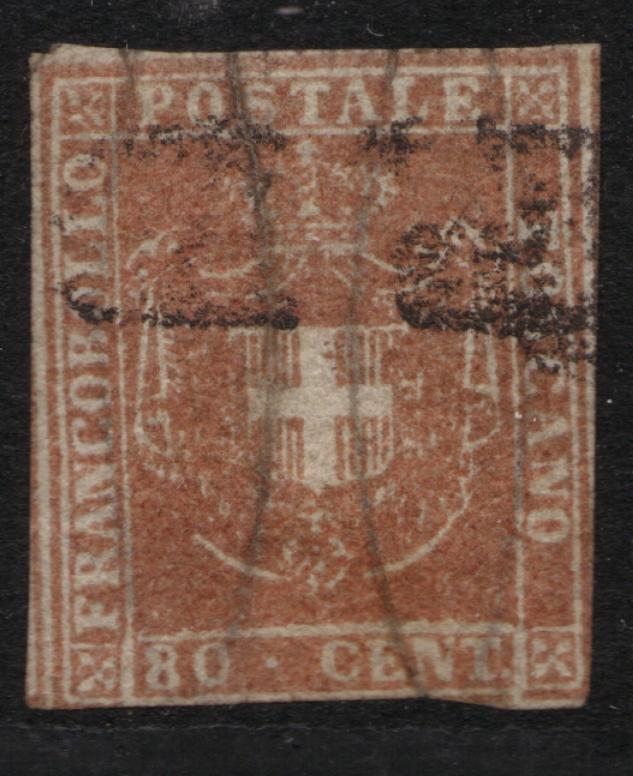
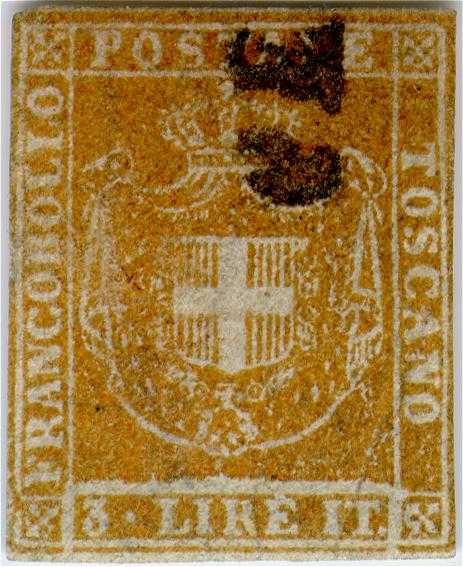
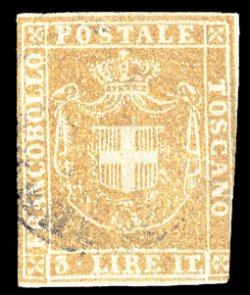
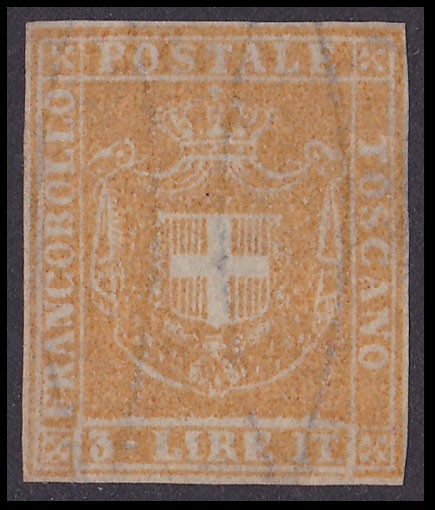
Return To Catalogue - Tuscany (Italy) 1851 issue - Italy
Note: on my website many of the
pictures can not be seen! They are of course present in the cd's;
contact me if you want to purchase them: evert@klaseboer.com.
With thanks to Lorenzo, (check his excellent website on Italian States!) who kindly set some of his images at my disposal.
For Tuscany (Italy) 1851 issue click here
1 Centes lilac 5 Centes green 10 Centes brown 20 Cent blue 40 Cent red 80 Cent red 3 Lire IT yellow
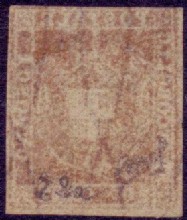
Watermark seen from the backside of a certified genuine 80 c
stamp
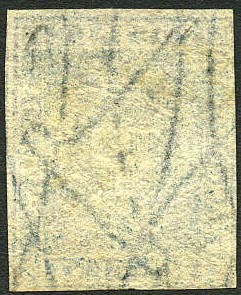
Backside of a 20 c stamp with parts of a word in the watermark
For the specialist: these stamps have watermark 'wavy crossing lines' (see picture at previous issue). In the middle of the sheet a slanting inscription 'I 1 E R R POSTE TOSCANE' exists in this watermark. Some stamps show a part of these words. The most common stamp is the 10 c. The 3 L is extremely rare. The 40 c is known to exist bisected to serve as two 20 c stamps.
Value of the stamps |
|||
vc = very common c = common * = not so common ** = uncommon |
*** = very uncommon R = rare RR = very rare RRR = extremely rare |
||
| Value | Unused | Used | Remarks |
| 1 c | R | *** | |
| 5 c | RR | *** | |
| 10 c | *** | * | |
| 20 c | RR | *** | |
| 40 c | RRR | *** | |
| 80 c | RRR | RR | |
| 3 L | RRR | RRR | |
In the early 20th century already 7 forgeries existed (according to Album Weeds), the first thing that can be checked is the presence of a watermark (but some forgeries have watermark too). The bottom line is always open at two places at the bottom (since the value was added in). The pearls at the extreme right and left of the crown are elongated. Examples of forgeries:
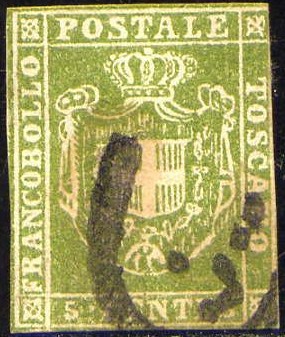
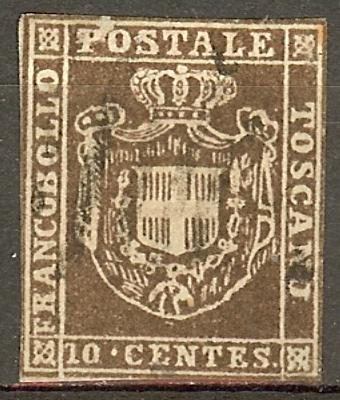
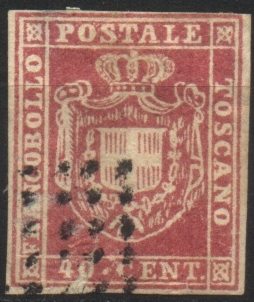
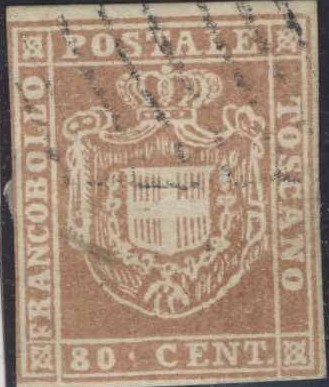
The above forgery is described as the second forgery in Album Weeds. The cross on the crown (or rather the ball that is supposed to be the cross), is situated to the right of the 'T' of 'POSTALE'. In the genuine stamps it is always slightly to the left. The side-folds at the right side end at the beginning of the last 'O' of 'TOSCANO' (it should go to the end of the 'N' of the same word). Many other small differences can be observed. Album Weeds says that at least the values 5, 10, 20 and 40 c exist (the 80 c also exists, see image above). I've seen these forgeries with the cancel with the dots as shown above or an ellipse with parellel lines in it. Album Weeds says that also circular cancels with a cityname and 'P.D.' can be found on these forgeries. I've also seen it with the very peculiar bogus cancel as shown on the 5 c (roughly half a circle with some blotches inside), which indicates this forgery might have been made by the same forger that made some forgeries of Sicily:

Forgery of Sicily with the same bogus cancel.
The bottom line has almost always two white holes in it in the genuine stamps (and in some forgeries aswell) so the white lines coming from above are continued. This was done to add in the value part. In the stamps shown below, these white holes are absent.
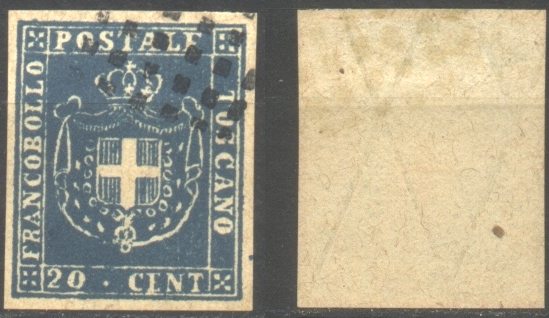
(these forgeries can be found with some kind of 'watermark'
consisting of lines)
The cross on the crown is placed to the right of the 'T' of 'POSTALE' in the above forgeries (it should be slightly to the left). The pearls on the crown are either absent or very blotchy. There are white dots in the mantle. The chain around the central cross is replaced by circles in this forgery. There is a ring at the bottom of the mantle. Album Weeds describes this forgery as the third forgery. It says it is unwatermarked, however, the last stamp has a watermark constisting of crossing lines (see picture above). Maybe not all forgeries have this watermark. The cancels that can be found on these forgeries are typically Spiro cancels: dots or lines as shown above. I have also seen the 10 c and 40 c values of this forgery.
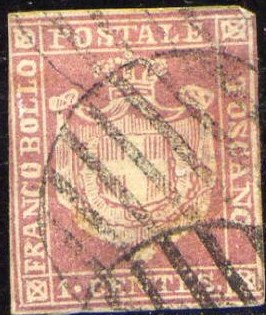
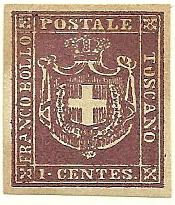
A rather primitive forgery, with the lettering different from the
genuine stamps (for example the 'S' of 'TOSCANA' or the 'P' of
'POSTALE'); also the cancel is a bogus cancel, a circle with
horizontal lines. The uncancelled forgery next to it might have
been produced by the same forger.
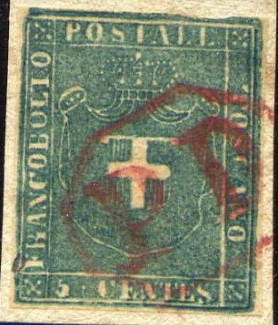
Quite blur forgery with circular dots on the crown and many other
design differences; it is cancelled with a red 'PD' cancel in an
octagonal.
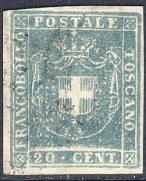
(Reduced size)
These are the forgeries offered by Fournier in his 1914 pricelist (5 values for 1.50 Swiss Francs) as second choice forgeries (because the quality is not very good I presume). The 1 c, 5 c, 10 c, 20 c, 40 c and 80 c were offered (the 3 Lire apparently not). These forgeries often have a solid line below the value label, above it some blotchy white space can be seen. A '8' or 'B' alike symbol is found some distance right to the 'R' of 'FRANCOBOLLO', above the value. Many white spots are visible in the design (they seem to be at the same location in every forgery); to the left of the 'T' of 'TOSCANO' there is a white line. Note that the 80 c has a watermark that can be seen from the front of the stamp (I don't know if the other forgeries have a watermark).

Forged cancels made by Fournier as found in 'The Fournier Album
of Philatelic Forgeries', reduced sizes.
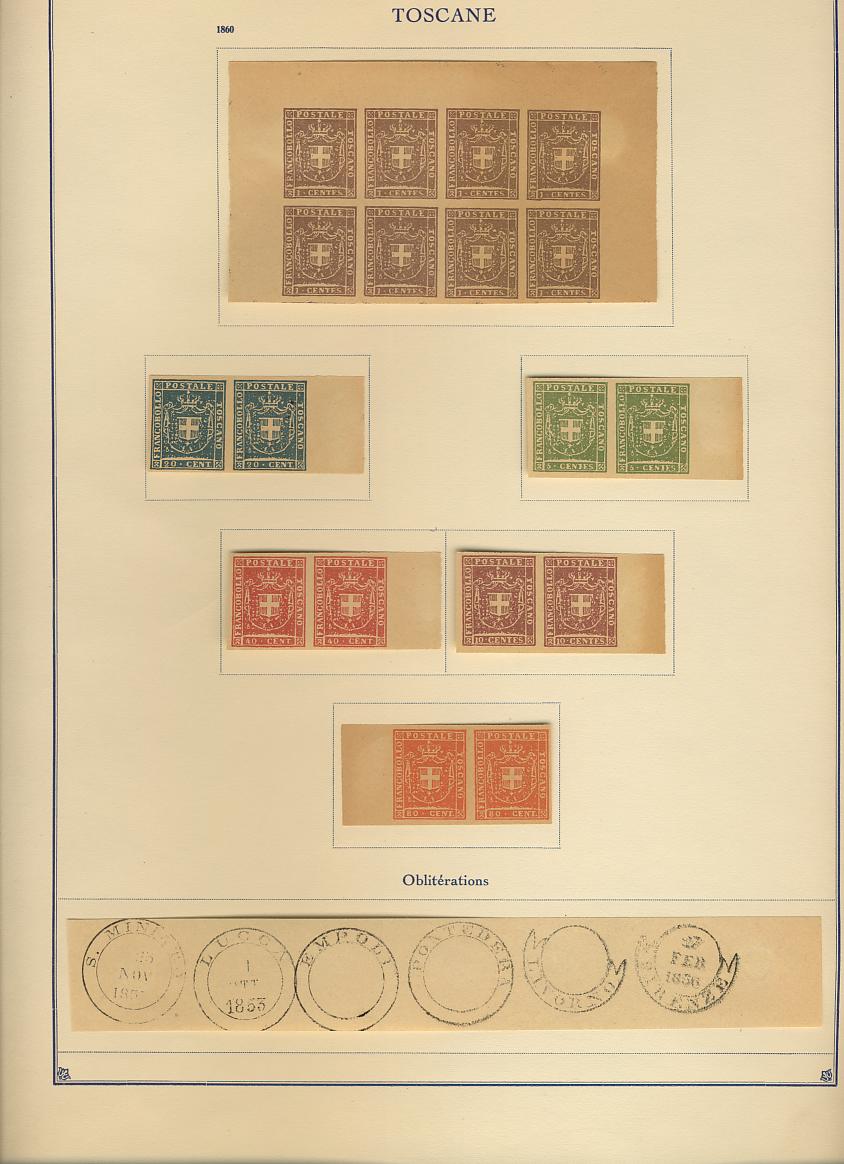
A page from a 'Fournier Album of Philatelic Forgeries' showing
some Fournier forgeries of this issue.
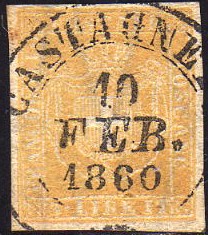
I've been told that this forgery of the 3 L value is also a
Fournier forgery, I'm not certain if this information is correct.
This forgery does not resemble the above ones. It has the cancel
'CASTAGNE.. 10 FEB. 1860'.
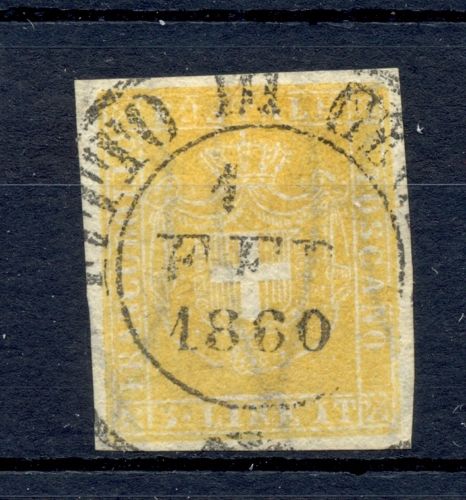
Very dubious item, made by the same forger?
Other forgeries with no white holes in the bottom line:
And some more forgeries with no white holes in the bottom line, they all have the cancel "15 MAG 1860 FIRENZE" and a watermark. I've also seen a 20 c blue (with the '2' very badly done) and even a 5 L orange exists:
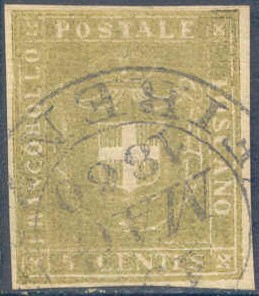
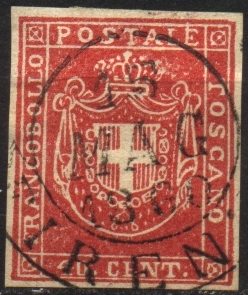
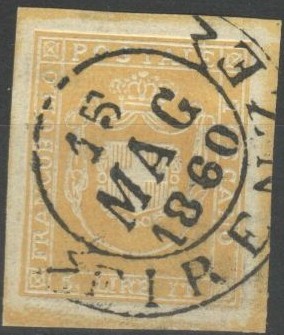
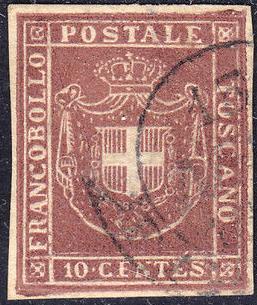
Forgeries with cancel "15 MAG 1860 FIRENZE"
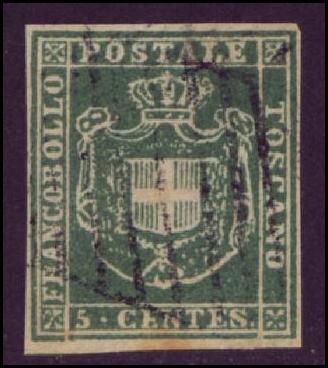
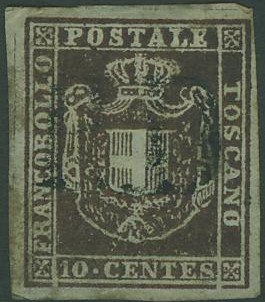
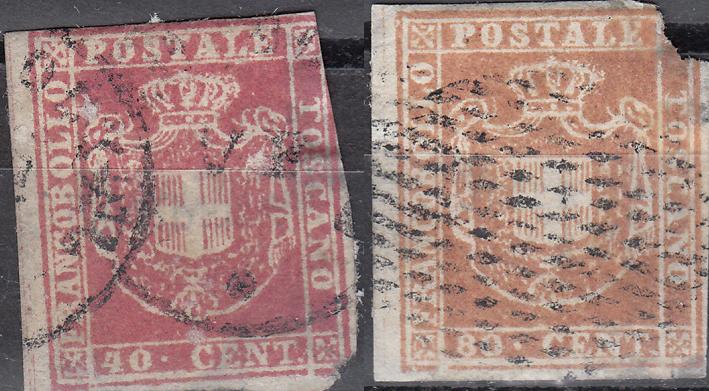
Forgeries with holes in the bottom, but with missing cross on top
of the crown. Also note the bogus cancels.
Other forgeries with holes in the bottom line:
Forgeries of the 3 L:
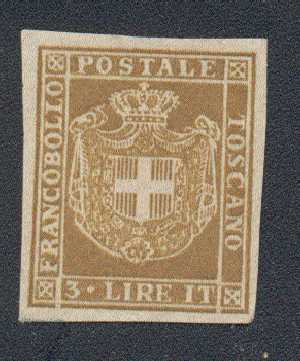
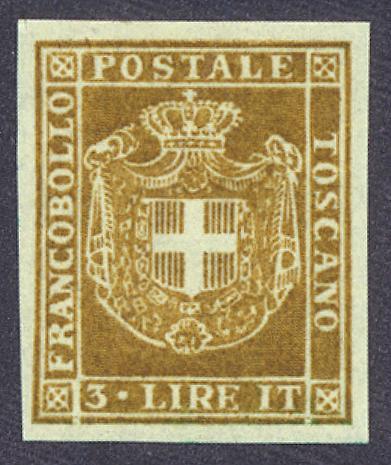
No dot behind 'IT' and too much drawing at the left top coat (to
the right of the 'LL' of 'FRANCOBOLLO').
The 3 L is very rare and the genuine stamps should have a dot after the '3', level with the center of the '3' and a dot behind the 'IT', level with the bottom of it (according to Album Weeds). The above two stamps don't have this last dot (for a genuine copy see above).
The forger Usigli (Turin, Italy) made a forgery of the 3 L on original paper, which he obtained from border of genuine sheets (source: Schweiz. Philatelistische Nachrichten in February 1910 or http://briefmarken.ag/), using the original printing plate, but with an altered value part. Sorry, no picture available yet of such a Usigli forgery.
A forgery with watermark:
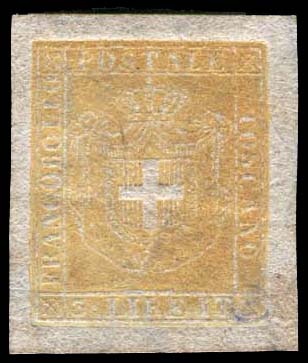
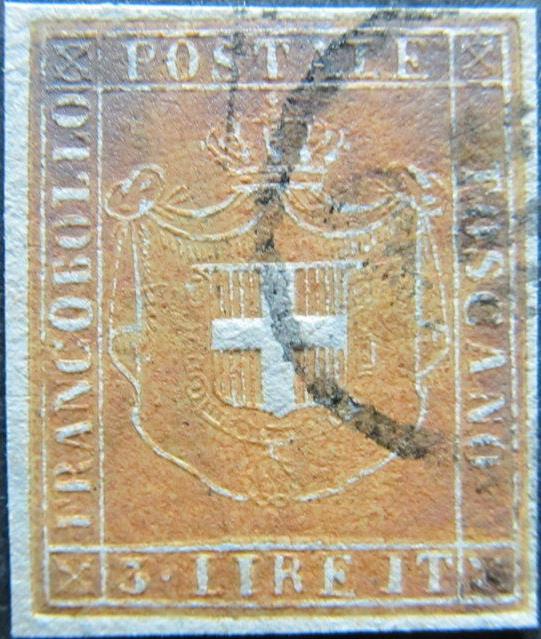
Forgery of the 3 L with watermark; the stamp next to it is
probably from the same forger. The design is almost 'embossed'.
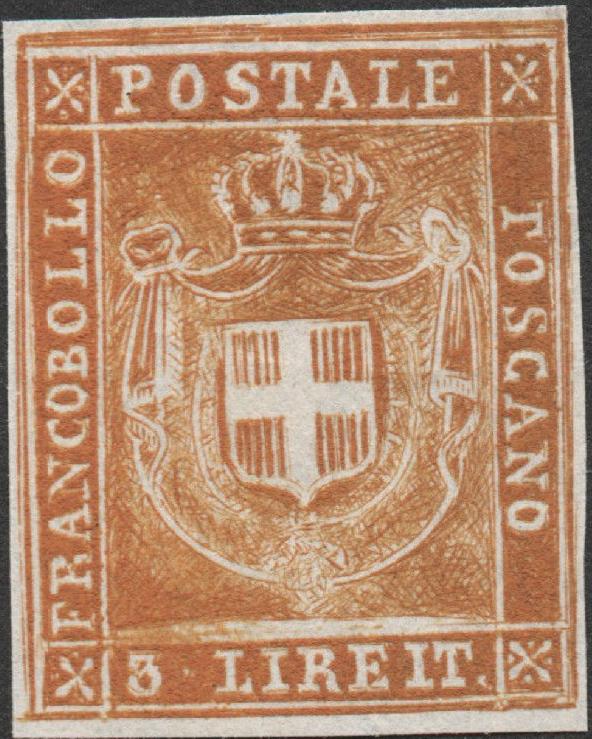
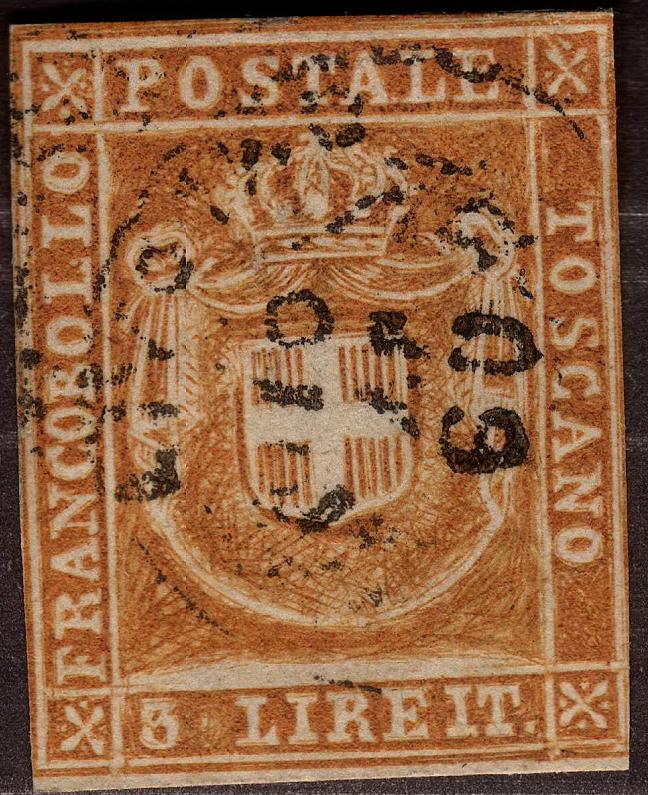
An even stranger heavily engraved forgery.
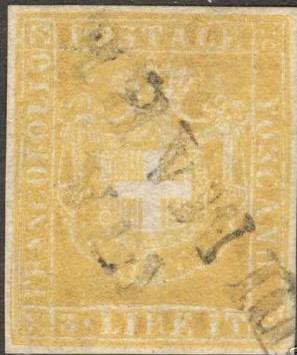
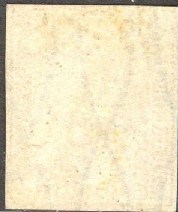
(Another forgery of the 3 L with watermark and cancel 'VIA DI
MARE')
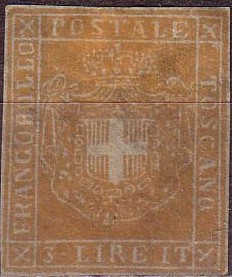
Another forgery of the 3 L value.
A bogus value of 1 Lire in red:
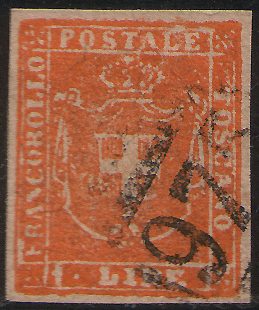
Also note the bogus '975' numeral cancel
Some forgeries with '2 4 6' printed at the bottom:
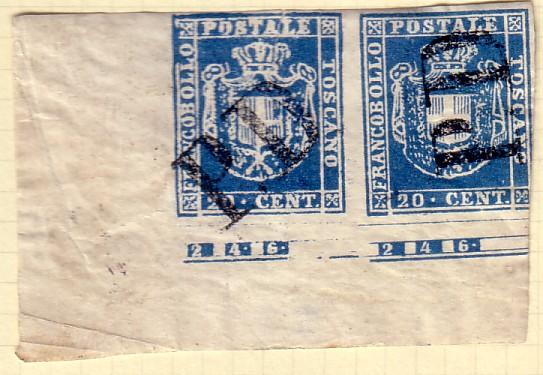

(Row of forgeries with bogus cancel)
Peter Winter forgeries
The forger Peter Winter has made forgeries of the values 5 c, 80 c and 3 L. They were made in the 1980's and have a rather 'modern' look.
Other modern forgeries:
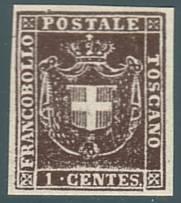
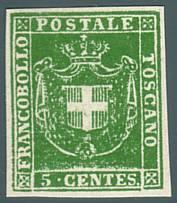
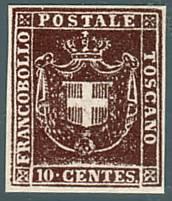
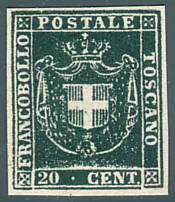


Other 'modern' forgeries on very white paper, there seems always
to be a white dot in the frameline above the 'P' of 'POSTALE'.
More of these modern forgeries for other
Italian States can be found by clicking here.
Sperati forgery
Sperati made a forgery of the 3 L value, he used a genuine stamp, bleatched out the design, leaving the cancel intact. Then he printed a forged 3 L design on this bleached stamp. His forgeries are very deceptive. They are not very common and quite valuable in itself. Sorry, no picture available yet.
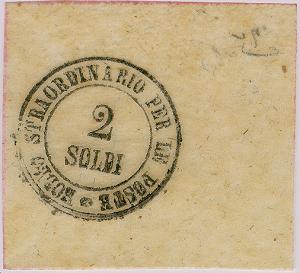
2 Soldi black
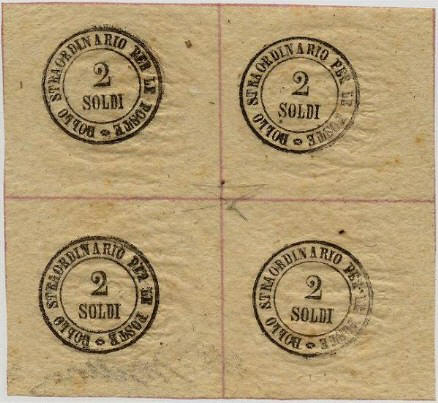
These stamps were seperated by hand-drawn red lines (about 4 centimeters apart). They are never cancelled and not sold to the public. It was printed in black on very thin, yellowish, almost transparent paper sheets. One sheet was composed of 80 pieces in 10 rows of 8 stamps each. This stamp was often cut very close to the circular print before being applied to the newspaper. Example of a stamp used on a newspaper:
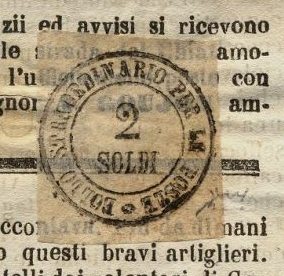
Value of the stamps |
|||
vc = very common c = common * = not so common ** = uncommon |
*** = very uncommon R = rare RR = very rare RRR = extremely rare |
||
| Value | Unused | Used | Remarks |
| 2 s | ? | *** | |
| Reprint | * | - | |
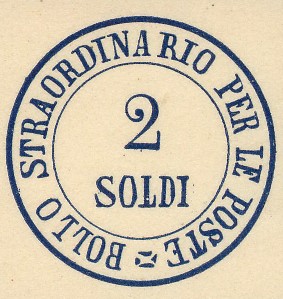
A Fournier forgery as it can be found in 'The Fournier Album of
Philatelic Forgeries'.
I think the next stamps are forgeries:
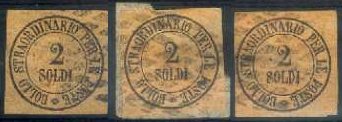
(Forgeries? Note the strange cancels, reduced sizes)
I have been told that the following labels are essays or proofs, however, I have no further information on these.
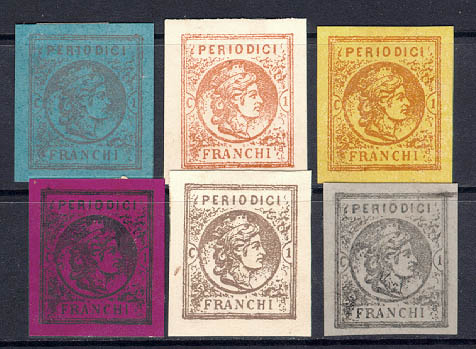
(Inscription 'PERIODICI FRANCHI')

(Inscription 'DA ESIGERE 3')